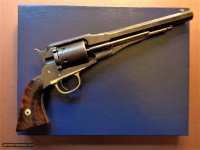Prior to the Richards Conversion Colt made the Thuer Conversion. The Thuer Conversion was an attempt by Colt to circumvent the Rollin White patent on revolvers with cylinders bored through to accept cartridges. The Thuer Conversions used an odd cartridge that was tapered, narrower at the rear than at the front, and the chambers were tapered to accept this cartridge. It was thought that because the bored through chambers were not cylindrical in shape, but were tapered, Colt could get away with making them without being sued by Smith and Wesson. The Thuer Conversions were mostly built on the 1851 Navy Colt and 1860 Army Colts, but there were some rare ones built on the 36 Caliber Pocket Models, the 36 Caliber 1862 Police Models, and some very rare 31 Caliber 1849 Pocket Models. There were even a few non-factory Thuer Conversions built on the Walker and Dragoon Models. The White Patent expired in 1869, and the first Thuer Models were also made in 1869. Only about 5,000 Thuer Conversions were made, from 1869 until 1872, they never sold very well because of the strange, reverse tapered cartridges.
More photos of my Colt Richards Conversion:
See my earlier post for a view of the right side of the revolver.
Completely disassembled except the screw holding the ejector rod assembly in place was too bunged up so I did not attempt to remove it.
This is the ejector rod assembly. It fits into the hole in the frame where the loading lever ram would normally go. The screw visible on the side of the barrel in the photo above is what held the ejector rod assembly in place. This was a complicated assembly. The ejector rod assembly of the later Richards-Mason Conversion was simpler and less expensive to manufacture.
The cylinder.
A comparison of the Richards Conversion Cylinder and the cylinder from a modern Italian replica 1860 Army Cap & Ball revolver. The earliest Richards Conversion cylinders were made by cutting down the C&B cylinder. The nipple area of the cylinder was machined away. Then a new ratchet star was machined from what remained. Later Richards Conversions had new cylinders made up from scratch. I have not lettered this one, I should, but I believe this one has one of the cylinders made from scratch, rather than a cut down C&B cylinder. Two of the 44 Colt rounds are sitting in the cylinder.
Frame
A Conversion Ring was added to the frame to take up the space of the missing nipple portion of the cylinder.
A frame mounted, spring loaded firing pin, similar to a modern Ruger firing pin, was mounted in the Conversion Ring, and a raised rear sight was incorporated onto the top of the Conversion Ring. The front of the hammer was machined away forming a flat surface to strike the firing pin.
A loading gate not too different from a SAA loading gate was mounted onto the Conversion Ring.
The White Patent was due to expire in April of 1869, and it was felt there would be little possibility of it being renewed. The Thuer Conversions had not proved to be commercially successful, so Colt engineers were hard at work coming up with experimental designs to convert existing stocks of C&B revolvers to cartridges. Charles B Richards was one of the best designers at Colt. His first patent for a breech loading revolver was granted on August 18, 1868. Another patent was issued in July 1871. The final patent was issued on July 25, 1871.
In
A Study Of Colt Conversions, and Other Percussion Revolvers, author Bruce McDowell states, "It is impossible to determine the exact date the Colt factory machinery started turning for the production of the Richards System, or the conversion of the Colt Model 1860 Army percussion revolvers to accept metallic cartridges". McDowell goes on to mention some letters from Army officials dated January 1871 inquiring about converting existing revolvers to fire cartridges. He states that an order was placed by the U.S. Ordnance Department to 'clean, repair, and alter or convert' 1000 revolvers on the last day of January, 1871. Colt records seem to indicate that by December 4, 1871 Colt had finished making the parts for that contract.
A table in McDowell's book seems to indicate that the majority of contracts for Richards Conversions had been completed by 1873, but a few were converted as late as 1880, long after the Single Action Army appeared in 1873.
The later Richards-Mason Conversion was a simpler conversion. The ejector rod mechanism of the Richards Conversion had been simplified, the frame mounted firing pin was eliminated in favor of a hammer mounted firing pin, and the Richards Conversion rear sight was eliminated in favor of a notch on the hammer nose, similar to the rear sights on most Colt percussion revolvers.

